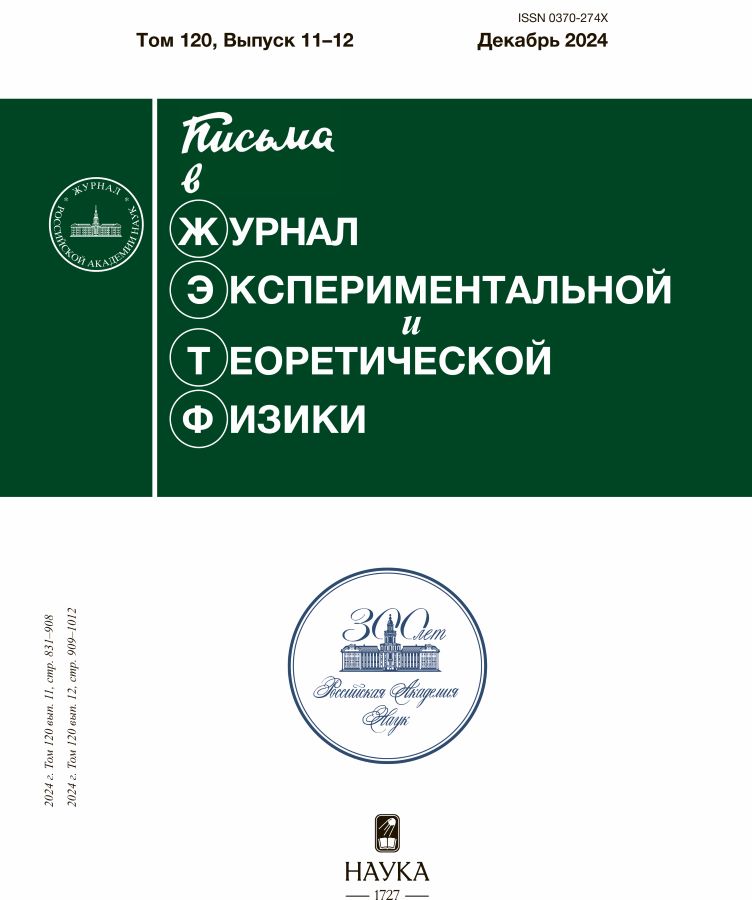Soft mode behavior in transition metal doped SrTiO3 thin films on MgO substrates
- 作者: Melentev A.V1, Zhukova E.S.1, Nekrasov B.M1, Stolyarov V.S.1,2,3, Frolov A.S.1, Savinov M.4, Bush A.A5, Kozlov V.I.5,6, Gorshunov B.P1, Talanov M.V1
-
隶属关系:
- Moscow Institute of Physics and Technology
- Dukhov Research Institute of Automatics (VNIIA)
- National University of Science and Technology MISIS
- Institute of Physics of the Czech Academy of Sciences
- Research Institute of Solid-State Electronics Materials, MIREA – Russian Technological University (RTU MIREA)
- Kapitza Institute for Physical Problems of the Russian Academy of Sciences
- 期: 卷 120, 编号 11-12 (2024)
- 页面: 943-945
- 栏目: Articles
- URL: https://rjraap.com/0370-274X/article/view/664453
- DOI: https://doi.org/10.31857/S0370274X24120183
- EDN: https://elibrary.ru/DDGMAJ
- ID: 664453
如何引用文章
详细
The ferroelectric soft mode in polycrystalline pristine SrTiO3 and weakly doped SrTiO3:M (M=2 at% Fe, Ni, Mn, Co) thin films on (001) MgO substrates has been studied using time-domain terahertz spectroscopy. Spectra of real and imaginary parts of film permittivity were determined in the frequency range of 5–100 cm−1 at temperatures between 5 and 300K. Central frequency and dielectric contribution of the ferroelectric soft mode show Barrett-like temperature dependencies similar to crystalline SrTiO3. Large negative values of Curie temperature and enhanced positive values of Barrett quantum temperatures are discovered indicating that doped SrTiO3 thin films are farther from ferroelectric phase transition than SrTiO3 crystals.
作者简介
A. Melentev
Moscow Institute of Physics and Technology
编辑信件的主要联系方式.
Email: aleksandr.melentyev@phystech.edu
Dolgoprudny, Russia
E. Zhukova
Moscow Institute of Physics and Technology
Email: aleksandr.melentyev@phystech.edu
Dolgoprudny, Russia
B. Nekrasov
Moscow Institute of Physics and Technology
Email: aleksandr.melentyev@phystech.edu
Dolgoprudny, Russia
V. Stolyarov
Moscow Institute of Physics and Technology; Dukhov Research Institute of Automatics (VNIIA); National University of Science and Technology MISIS
Email: aleksandr.melentyev@phystech.edu
Dolgoprudny, Russia; Moscow, Russia; Moscow, Russia
A. Frolov
Moscow Institute of Physics and Technology
Email: aleksandr.melentyev@phystech.edu
Dolgoprudny, Russia
M. Savinov
Institute of Physics of the Czech Academy of Sciences
Email: aleksandr.melentyev@phystech.edu
Czech Republic
A. Bush
Research Institute of Solid-State Electronics Materials, MIREA – Russian Technological University (RTU MIREA)
Email: aleksandr.melentyev@phystech.edu
Moscow, Russia
V. Kozlov
Research Institute of Solid-State Electronics Materials, MIREA – Russian Technological University (RTU MIREA); Kapitza Institute for Physical Problems of the Russian Academy of Sciences
Email: aleksandr.melentyev@phystech.edu
Moscow, Russia; Moscow, Russia
B. Gorshunov
Moscow Institute of Physics and Technology
Email: aleksandr.melentyev@phystech.edu
Dolgoprudny, Russia
M. Talanov
Moscow Institute of Physics and Technology
Email: aleksandr.melentyev@phystech.edu
Dolgoprudny, Russia
参考
- J.H. Barrett, Phys. Rev. 86, 118 (1952).
- J. Petzelt, T. Ostapchuk, I. Gregora et al. (Collaboration), Phys. Rev. B 64, 184111 (2001).
- T. Ostapchuk, J. Petzelt, V. ˇZelezny et al. (Collaboration), Phys. Rev. B 66, 235406 (2002).
- J. Petzelt, T. Ostapchuk, I. Gregora, M. Savinov, D. Chvostova, J. Liu, and Z. Shen, J. Eur. Ceram. Soc. 26, 2855 (2006).
- M.V. Talanov, A. I. Stash, S.A. Ivanov, E. S. Zhukova, B. P. Gorshunov, B.M. Nekrasov, V. Stolyarov, V. Kozlov, M. Savinov, and A. Bush, J. Phys. Chem. Lett. 13, 11720 (2022).
- A. Tkach, P.M. Vilarinho, and A. Kholkin, Ferroelectrics 304, 87 (2004).
- M. Savinov, V.A. Trepakov, P.P. Syrnikov, V. ˇZelezny, J. Pokorny, A. Dejneka, L. Jastrabik, and P. Galinetto, J. Phys. Condens. Matter 20, 095221 (2008).
- A. Tkach, P.M. Vilarinho, A.L. Kholkin, A. Pashkin, S. Veljko, and J. Petzelt, Phys. Rev. B 73, 104113 (2006).
- S. Maletic, D. Maletic, I. Petronijevic, J. Dojcilovic, and D.M. Popovic, Chin. Phys. B 23, 026102 (2013).
- S. Kojima, 2022 Photonics & Electromagnetics Research Symposium (PIERS), IEEE, Hangzhou, China (2022).
- J. Petzelt and S. Kamba, Ferroelectrics 503, 19 (2016).
- I. Katayama, H. Shimosato, M. Ashida, I. Kawayama, M. Tonouchi, and T. Itoh, J. Lumin. 128, 998 (2008).
- E. S. Zhukova, B.M. Nekrasov, M. Tyunina et al. (Collaboration), J. Alloys Compd. 976, 173255 (2024).
补充文件









